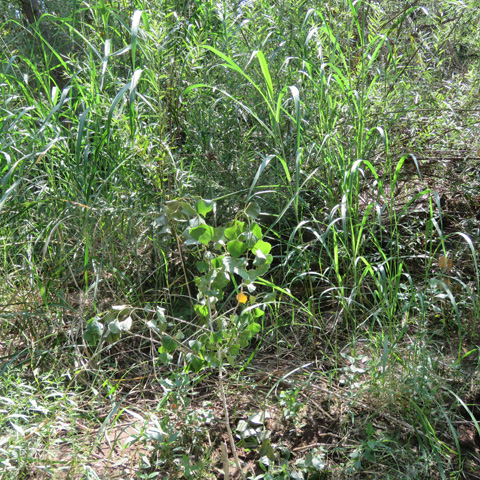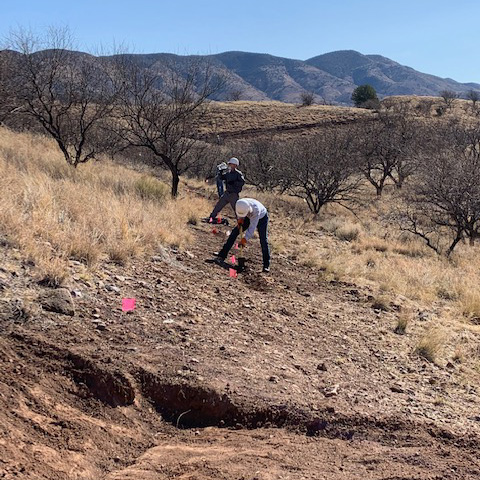Cottonwood Regeneration
In the spring/summer Arizona’s native cottonwood, the Fremont cottonwood (Populus fremontii), drop their cottony seeds along Sonoita Creek creating a wintery scene. With so many seeds covering the ground it’s hard to imagine that the creek bank is not overflowing with young cottonwoods but the seeds are having a tough
time germinating. Drought stress, changes in hydrology, changes in the landscape, climate and invasive species all play a roll in seedling death. Cottonwoods stabilize stream banks, which helps control erosion, provide shade for wildlife and native fish as well as habitat for insects, birds and the predators that feed on them.
In February of 2016 six Friends of Sonoita Creek members planted eight live Fremont cottonwood stakes along a stretch of Sonoita Creek in the Patagonia-Sonoita Creek Preserve. Today only one survives. Some were scoured out during the flood of August 2016 and some were heavily browsed. One’s a start.
In August of 2020 eighteen more cuttings were taken from a recently downed cottonwood, seven of those were immediately planted along Sonoita Creek and eleven were taken to Borderlands Restoration where they are being tended by nursery staff until they can be put in the ground. This effort is ongoing so there will be future opportunities to help FOSC restore cottonwoods along Sonoita Creek.

Trails
Friends of Sonoita Creek is honored to help financially support the Dirtbags, the local all volunteer trail building and trail maintenance crew. In 2020, with 20-25 volunteers, they put in over 2300 hours working to re-route the Arizona trail, connecting two larger trails.
Read about ongoing efforts in the Patagonia Regional Times article below.
Dirtbags Restore Area Trails
By Bob Brandt, for the Patagonia Regional Times, January 2020 issue
Normally calling someone a dirtbag might earn you a punch in the nose, but for the cadre of mostly ‘mature’ men and women who build and maintain trails in and around Patagonia, the term is a source of pride. They’ve even taken to donning caps declaring their membership in this group.
Working mainly in the fall and winter months under the direction of crew leader Chris Strohm and his assistant, Joe Watkins, the Dirtbags this season have already reconditioned several of the most popular trails in the area.
They began the season’s work by restoring and upgrading the Sonoita Creek-Blackhawk Loop at the Sonoita Creek State Natural Area, the birding trail at Patagonia Lake State Park and the newly-named Paul Baird Trail that connects the Paton Center for Hummingbirds and The Nature Conservancy’s Patagonia-Sonoita Creek Preserve.
Also adjacent to the Paton Center, the Dirtbags supplied much of the labor needed to create a new birding trail that meanders through part of a 5-acre parcel now known as the Cuckoo Corridor that was recently transferred to Tucson Audubon by the Conservancy. This new loop trail begins across the road from the Paton Center and will eventually connect with the Montessori Trail.
Most recently, the group completed reconditioning of the two-mile Smith Canyon Loop Trail, a dominant feature of the Borderlands Wildlife Preserve which is owned and managed by Wildlife Corridors, LLC. They also cleaned up the new connecting trail that links the Smith Canyon Loop with the primitive cross corridor road that traverses the preserve.
The all-volunteer Dirtbag crew, which is affiliated with, and financially supported by, Friends of Sonoita Creek, is open to having new members join their ranks. If you enjoy physical labor and being outdoors, and for more information or to sign up, please contact Joe Watkins (520-377-7294) or Chris Strohm (520-394-0280).

Fencing Survey of Sonoita Creek State Natural Area
In conjunction with the Arizona State Parks and the State Natural Areas, Friends of Sonoita Creek assisted personnel from the State Natural Area and Arizona Game and Fish on the fencing survey of Sonoita Creek State Natural Area to determine repairs needed.
FOSC volunteers surveyed in rough terrain for four days for a total of 222 hours. Cattle are constantly encroaching on the Natural Area land, destroying springs and the creek banks, eating young trees that are necessary to sustain the riparian area and tearing down the fences that keep them out of the Natural Area. Unfortunately, due to budget constraints, the fence is yet to be repaired.

